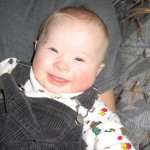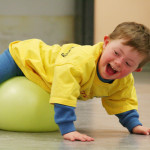¨ Baby’s First Signs (hardcover) by Kim Votry & Curt Waller
¨ More Baby’s First Signs (hardcover) by Kim Votry & Curt Waller
¨ Best Worst Brother, The by Stephanie Stuve-Bodeen
The sequel to “We’ll Paint the Octopus Red”, is a realistic look at how a sibling relationship evolves. While Emma misses Isaac being an adorable baby, and finds him frustrating at times, she takes great pride in his eventually learning to sign.
¨ Busy Little Mouse by Eugenie and Kim Fernandes
¨ Elusive Moose (hardcover) by J. Gannij & C. Beaton
¨ Giraffes Can’t Dance by Giles Andreae & Guy Parker-Rees
Gerald the giraffe doesn’t really have delusions of grandeur. He just wants to dance. But his knees are crooked and his legs are thin, and all the other animals mock him when he approaches the dance floor at the annual Jungle Dance. “Hey, look at clumsy Gerald,” they sneer. “Oh, Gerald, you’re so weird.” Poor Gerald slinks away as the chimps cha-cha, rhinos rock ‘n’ roll, and warthogs waltz. But an encouraging word from an unlikely source shows this glum giraffe that those who are different “just need a different song,” and soon he is prancing and sashaying and boogying to moon music (with a cricket accompanist). In the vein of Rudolph the Red-Nosed Reindeer, Gerald’s fickle “friends” quickly decide he’s worthy of their attention again.
With this rhyming, poignant (in a cartoonish way) tale, Giles Andreae, author of Rumble in the Jungle, and numerous other picture books, shows insecure young readers that everyone can be wonderful, even those that march to the beat of a different cricket. The rhymes are somewhat awkward, but the bold, bright watercolors by Guy Parker-Rees will invite readers to kick up their heels and find their own internal harmony. ( Ages 3 to 6 )
¨ My Friends (hardcover) by Taro Gomi
¨ My Friend Has Down Syndrome by Jennifer Moore-Mallinos
The sensitively written Let’s Talk About It Books encourage preschool-age and early-grades children to explore their feelings, deal with problems that trouble them, and understand others who have problems of their own. Each title speaks to a particular concern that children might encounter in the course of growing up. All books in this series have appealing color illustrations on every page, and are available in both English and Spanish language editions. A short section at the back of each book offers related advice to parents. My Friend Has Down Syndrome describes a condition that affects many families. Younger children are normally puzzled when they encounter other kids who suffer from Down syndrome. Here is a heartwarming and reassuring story of how an ordinary child comes to understand and befriend another child who has Down syndrome.
¨ My Friend Isabelle by Eliza Woloson
Isabelle and Charlie are great friends. They draw, dance, read, play and eat cheerios together. A wonderful story about friendships being special and differences making our world a better place.
¨ My Sister Alicia May by Nancy Tupper Ling
Based on the lives of two sisters, this story expresses the challenges and joys of growing up with a sibling who has special needs. In many ways, Rachel and Alicia are like any sisters, but Rachel knows her sister is very different and very special because she has Down syndrome. Though Rachel occasionally feels frustrations and resentment about having to help watch over her special sister, she most often feels love, acceptance, and pride for her. Exquisitely written with humor and compassion, this story focuses on the sisters’ relationship and their respective places in the family.
¨ More Simple Signs by Cindy Wheeler
¨ Our Brother Has Down syndrome by Shelley Cairo
In a simple language, and illustrated with photographs three sisters describe the ways in which little brother Jai, a Down’s Syndrome child, is different from other children, and what the family does to help him get along.
¨ Sheep on a Ship (hardcover) by Nancy Shaw
¨ Silly Suzy Goose (hardcover) by P. Horacek
¨ Simple Signs by Cindy Wheeler
¨ We’ll Paint The Octopus Red by Stephanie Stuve-Bodeen
Emma and her father discuss what they will do when the new baby arrives, but they adjust their expectations when he is born with Down syndrome. A good siblings book with questions and answers at the end about Down Syndrome.
¨ What’s Wrong with Timmy? By Maria Shriver
When 8-year-old Kate meets a boy who seems somehow different, she feels funny inside. After talking with her mom, though, Kate begins to understand that Timmy is just like her in many ways. Timmy has special needs; he takes longer to learn than Kate, and can’t walk or run as well. But he also “loves his family, he wants friends, he goes to school, and he dreams about what he wants to be when he grows up.” Kate and Timmy meet, and the seeds of a friendship are planted.
For all those children who ask their parents why someone looks or acts “different,” author and journalist Maria Shriver’s What’s Wrong with Timmy? provides a base for discussion. Kate’s mother models appropriate behavior, speaking to her daughter calmly and directly, and providing examples from her own life to help Kate understand about Timmy. Illustrator Sandra Speidel’s soft, intentionally hazy pastels are lovely; bold, enlarged phrases on the opposite pages of text act as captions. Shriver and Speidel collaborated previously on the tremendously popular What’s Heaven?, also starring Kate and her mother. ( Ages 4 to 8 )
¨ Where is the Green Sheep? (hardcover) By M. Fox & J. Horacek
¨ Who is Mr. Piggy Pig? By S. Jangjiravat
Based on the author’s own experience with a relative who has Down Syndrome, “Who is Mr. Piggy Pig” relates the heartwarming story of a young pig with Down Syndrome who was nurtured and encouraged by his family to be a productive member of society. As a result, when he is older he helps other children with special needs.
Although the story is set in Thailand, the theme of giving to others is universal. The text is easy to understand, and the artwork is beautiful. Children will be enchanted with the pictures of the piglets attending Chuanchuen Home School.
This book could be used as a curriculum selection for family, giving, special needs, or multicultural themes.


